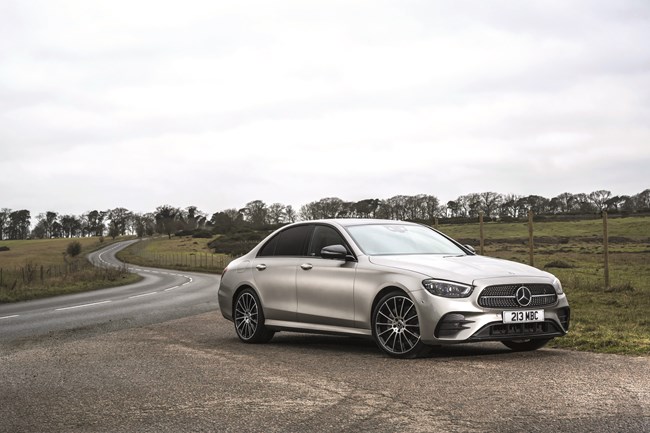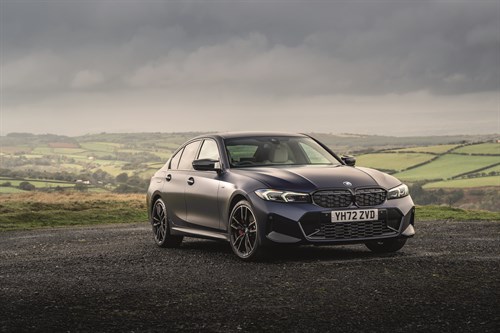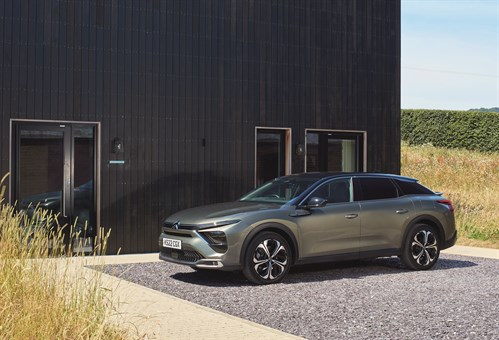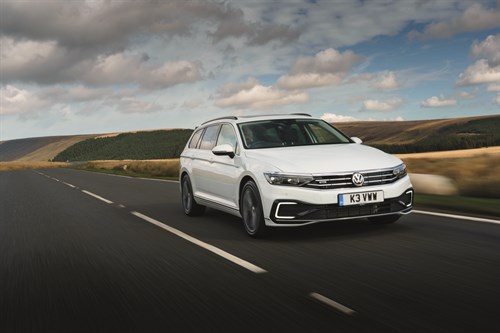We use cookies to ensure that we give you the best experience on our website. If you continue without changing your settings, we will assume that you are happy to receive all cookies on the Business Car website. However, if you would like to, you can change your cookies at any time

The start point for the best source of fleet information |
Best in Class: Upper-medium plug-in hybrids
Date: 20 December 2022 | Author: Martyn Collins

Mercedes-Benz C-Class
When you first see the latest Mercedes-Benz C-Class - the sixth-generation version of Merc's upper-medium model, it's slightly underwhelming. It doesn't really stand out, although the sleek exterior design looks stylish enough - it's basically a scaled-down version of theirange-topping S-Class. In fact, the only giveaway, that this is a plug-in hybrid, is the extra fuel filler on the left of this car.
Move inside, and things are largely the same, although you can't miss the C300e's 11.6in iPad-like touchscreen that curves out of the centre console for the latest MBUX infotainment system. Another debut from the latest S-Class, although we'd argue it looks more impressive in the smaller C-Class. A complex system that has been designed around personal profiles. After getting into the car, you sign in and the car adjusts to your perfect driving position - it even puts on your favourite radio station. Considering MBUX's complexity, we're grateful for the fact that it's easy to use.
Elsewhere, the C-Class's interior is attractive, well-designed, and high-quality. Rear legroom is better than the last-generation car but feels tighter than it should be - even for children. The most noticeable interior compromise for the C300e, is the observable drop in boot space - 140 litres in fact - thanks to the hybrid battery. Although still practical, it totals 315 litres.
The main fleet interest points with the latest C-Class are the availability of plug-in hybrid versions, like the one we're comparing here. However, the rest of the diesel and petrol engines are mild hybrids, with the 48V system, allowing the C-Class to coast with the engine off and offering a small power boost when accelerating.
The C300e we're focussing on here is powered by a 204hp, 2.0-litre petrol turbo engine combined with a 24.5kWh battery and 95kW electric motor, equalling an impressive 313hp. So, the performance figures are good, but company car drivers are going to be keener on the 5% BIK charge, emissions as low as 12g/km, with Mercedes claiming an average economy of a scarcely believable 565mpg, and 68 miles range on electric power alone. This is 27 miles more than its closest rival, the BMW 330e, can manage. It is credible too, as when we had this car, we saw 40 miles, on our longest 228-mile round trip, which was mostly covered on the motorway, and it wasn't fully charged when we set off.
So, we know the PHEV version of the petrol C-Class is an impressive car, but how does it stack up against other plug-in hybrid rivals, such as the BMW 330e, Citroen C5X and even the Volkswagen Passat - read on to find out which comes top.
PHEV versions of Mercecdes' C-Class have previously scored well for residuals, and the new model carries on that tradition, as it comes first with its 40.88% figure. Its closest rival, the second most expensive model of the four, the BMW 330e, coming second. According to the P11D figure, the Mercedes is the most expensive of the group, and it has the third highest depreciation figure of the four at £28,764. The Mercedes is followed again by the BMW (£27,721), Citroen (£26,544) and in last place is the Volkswagen at £29,845.
According to fuel figures supplied by Key Resources, this plug-in Mercedes is capable of 43.5mpg, which is more than the BMW and Volkswagen, but not quite enough to better the Citroën from the top position with its 44mpg figure. Most surprising here, is the fact that the BMW finishes last, but all this plug-in group are very close in terms of their figures.
Where you see the benefit of the C300e's 69-mile EV-only range, is in terms of its Benefit in Kind (BIK) figure and at 5%, is significantly lower than the rest of the group's 12% figure. Overall, the Mercedes scores well enough - especially in terms of BIK. But that's not enough here for the C300e to score the best cost per mile figure, as its high list price has an effect, putting this car in second place.
Mercedes-Benz C300e AMG Line
P11D: £48,655
CO2 (tax):12g/km (5%)
BIK 20/40% a month: £41/£81
Fuel consumption: 43.5 mpg
National Insurance: £1,098
First year VED: £0
Subsequent VED: £155
Engine size/power: 1,999cc + 24.5kWh/313hp
AFR: 17p
Residual value: 40.88%
Depreciation: £28,764
Fuel costs: £6,469
SMR: £2,405
Cost per mile: 62.73p

BMW 3 Series
The C-Class runs it close, but the seventh-generation BMW 3 Series remains king of the premium cars in our opinion. Indeed, it won the Best Premium Car award for the fourth year running at the Business Car Awards 2022.
Whatever 3 Series you choose, you won't be disappointed by the driving experience. In addition to the performance, other driving highlights are the precise steering and tidy handling. The ride and refinement are well-judged, too.
Our favourite and a key choice for fleets, is the BMW 330e plug-in, which combines a 181hp 2.0-litre petrol engine with an 11.15kWh battery and 88kW electric motor, which together equal up to 35 miles of EV range, a total of 288hp and BIK starting at 12%.
Just facelifted, the biggest facelift change is to the interior, with the addition of tech borrowed from another of our winners - the BMW i4. Now fitted with a huge, curved display made of two screens, running an intuitive infotainment system that can be interacted via voice or gesture control. Like the i4, the 3 Series also benefits from all the features of the MyBMW app.
Thanks to the smaller 35-mile EV range, the BMW achieves the same 12% BIK figure as the Citroen and Volkswagen. The 330e's figures are close to the other cars in this group, and despite a mid-placed depreciation figure, its high price, biggest SMR figure and lowest economy figure mean our favourite can only finish third here.
BMW 330e M Sport
P11D: £46,075
CO2 (tax): 31g/km (12%)
BIK 20/40% a month: £92/£184
Fuel consumption: 40.35mpg
National Insurance: £2,422
First year VED: £0
Subsequent VED: £155
Engine size/power: 1,998cc + 12kWh /249hp
AFR: 17p
Residual value: 39.84%
Depreciation: £27,721
Fuel costs: £7,507
SMR: £2,495
Cost per mile: 62.87p

Citroen C5X
The C5X is a landmark car for Citroën, as it's the brand's first "big" car available in the UK since the C6, was discontinued in 2012.
Not a conventional upper medium class car, instead, it crosses over body styles, as Citroën claims the C5X offers the elegance of a saloon, the versatility of an estate and the presence of an SUV.
The C5X is available with 130hp or 180hp Puretech petrol engines, but of most interest to fleet buyers, is the plug-In hybrid version that we're highlighting here. The Plug-in Hybrid 225 can run in electric mode around town, meaning the plug-in is better at low speeds. On the road, you'll be impressed with the ride, refinement, bump absorption and comfort which are key here - but at the same time the dynamics are still decent. There might be a "Sport" mode, but don't expect too much of that, instead selecting this just gives the accelerator and steering welcome added resistance.
The Citroën's lowest SMR (£2,059), P11D (£40,115) and best fuel consumption figures (44mpg) are sure to have had the biggest effect on the C5X's first place result here, with its 58.92p figure. Considering the rather perilous position of Citroëns of this size from the past, the French manufacturer will surely be pleased with its first place, £26,544 depreciation figure.
Citroen C5X Hatch 1.6 PHEV Shine Plus
P11D: £40,115
CO2 (tax): 27g/km (12%)
BIK 20/40% a month: £80/£160
Fuel consumption: 44mpg
National Insurance: £2,173
First year VED: £0
Subsequent VED: £155
Engine size/power: 1,598cc + 12.4kWh/225hp
AFR: 17p
Residual value: 33.83%
Depreciation: £26,544
Fuel costs: £6,750
SMR: £2,059
Cost per mile: 58.92p

Volkswagen Passat
The plug-in hybrid version of the Passat is the oldest model here, having been originally launched along with the facelifted range, back in 2019.
Under the bonnet, the GTE hybrid model continues to be powered by a 1.4-litre petrol combined with a 9.9kWh electric battery, equalling 218hp and up to 37 miles of electric-only range.
GTE trim includes 17in alloys and LED headlights. You also get lane-keeping and changing assistance, adaptive cruise control, front and rear parking sensors and Volkswagen Connect compatibility. Elsewhere, this Passat also includes Vienna leather upholstery and satnav enabled infotainment system.
The Volkswagen is the second cheapest to buy here, with a £45,415 P11D figure, along with the second best SMR figure of £2,176. The Passat's 37 miles EV range equals the BMW and Citroën with a 12% BIK figure, although its mid-placed 34.37% residual value figure is a surprise - which is sure to have led to the Passat's last place finish here.
Volkswagen Passat 1.4TSI PiH GTE Advance Estate
P11D: £45,415
CO2 (tax): 28g/km (12%)
BIK 20/40% a month: £91/£182
Fuel consumption: 41.5mpg
National Insurance: £2,460
First year VED: £0
Subsequent VED: £155
Engine size/power: 1,395cc + 13kWh/218hp
AFR: 14p
Residual value: 34.37%
Depreciation: £29,845
Fuel costs: £7,418
SMR: £2,176
Cost per mile: 65.73p











